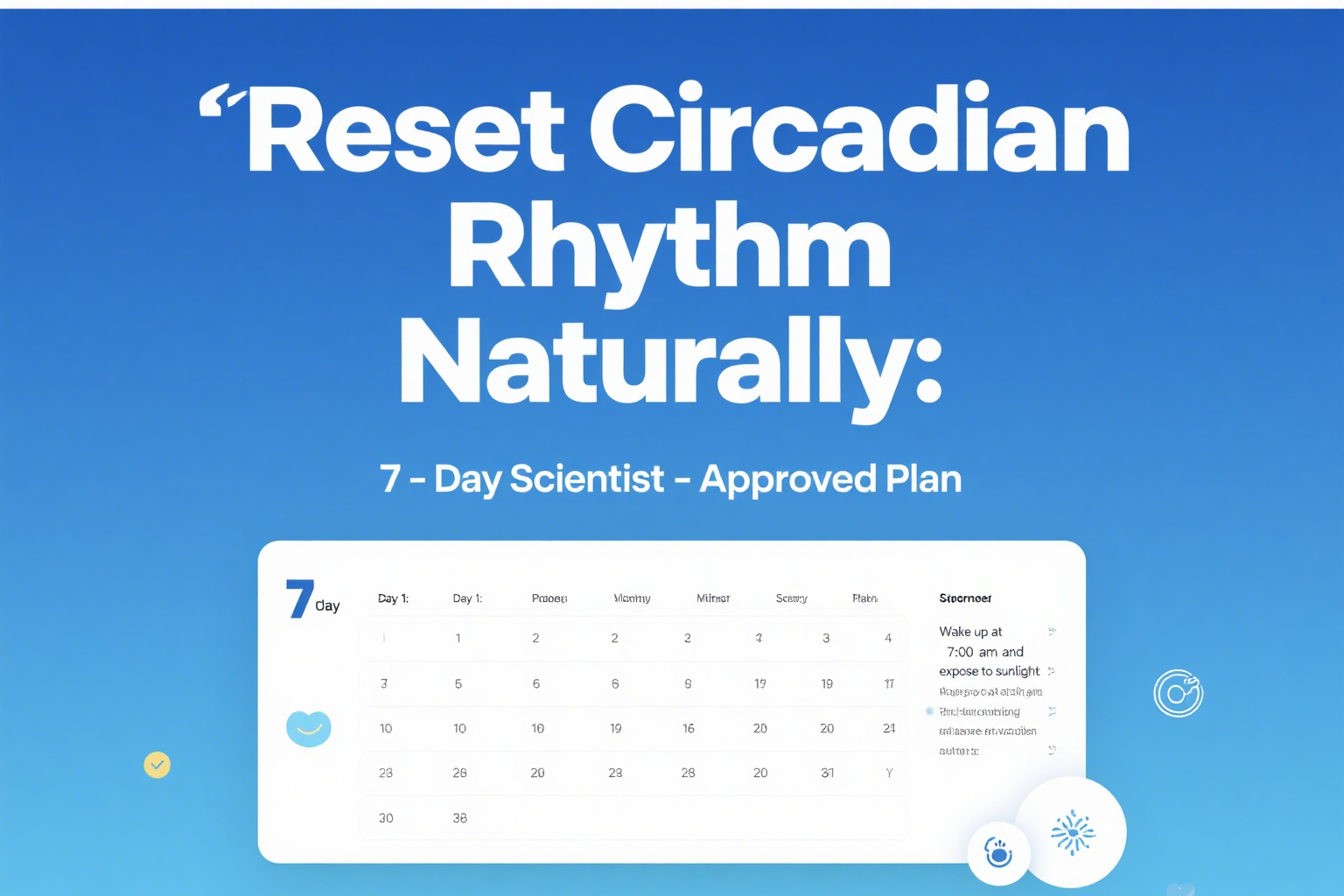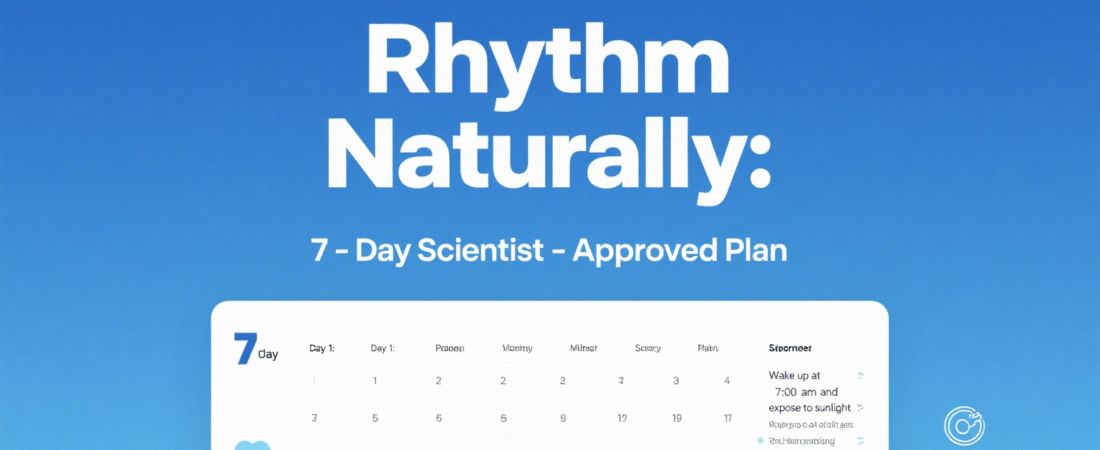Feeling perpetually out-of-sync? Like you’re living in the wrong time zone? You’re not alone. Modern life – artificial light, screens, erratic schedules – wreaks havoc on our internal clocks. The consequences? Poor sleep, low energy, mood swings, and even long-term health risks. But what if you could reboot your natural rhythm in just one week? This step-by-step protocol combines cutting-edge chronobiology with practical tools to help you reclaim your days and nights.

The Science of Your Sleep-Wake Cycle
Your circadian rhythm is governed by the suprachiasmatic nucleus (SCN), a tiny region in your brain acting as the master clock. Light is its primary cue (“zeitgeber”). Morning light signals “day,” suppressing melatonin and boosting cortisol for alertness. Evening darkness triggers melatonin release, preparing you for sleep. Disrupt this cycle (like scrolling in bed), and your entire system falters. This protocol strategically resets this delicate dance.
Your 7-Day Circadian Reset Protocol
- Day 1: Lock in Your Wake Time (The Anchor Point)
- Action: Set an alarm for your target wake-up time (e.g., 6:00 AM). Get up immediately, even if you slept poorly. This is your non-negotiable anchor for the week.
- Key Tool: Morning Light Exposure (Within 30 minutes of waking, get 15-30 minutes of bright, natural light outdoors. No sunglasses! Overcast? Use a 10,000-lux light therapy lamp positioned beside you).
- Avoid: Snoozing! It fragments sleep and confuses your clock.
- Day 2: Establish Your Light-Dark Cycle
- Action: Maintain anchor wake time. Focus on evening light hygiene starting 2-3 hours before bed.
- Key Tool: Dim indoor lights. Use apps like f.lux or iOS Night Shift to reduce blue light on screens. Consider amber-tinted glasses.
- Science: Blue light potently suppresses melatonin, delaying sleepiness.
- Day 3: Dial in Bedtime & Meal Timing
- Action: Calculate target bedtime based on your wake time and needing 7-9 hours (e.g., 10:00 PM for a 6:00 AM wake-up). Aim to wind down 60 mins prior. Stop eating 2-3 hours before bed.
- Key Tool: Consistent Schedule. Eat meals at roughly the same times daily. Food is a secondary zeitgeber.
- Track: Start noting sleep times & quality (use Oura Ring or simple journal).
- Day 4: Optimize Your Sleep Sanctuary
- Action: Ensure your bedroom is pitch dark (blackout curtains, cover electronics), cool (60-67°F / 15-19°C), and quiet (white noise if needed).
- Key Tool: Strategic Melatonin (Optional): If struggling to fall asleep earlier, consider 0.5-1 mg melatonin 60-90 minutes before your target bedtime. Consult your doctor first, especially if on medication. Not a long-term sleep aid.
- Longtail Integration: This step is crucial for how to reset circadian rhythm naturally – optimizing environment reduces reliance on supplements.
- Day 5: Amplify Morning & Daytime Signals
- Action: Maintain anchor wake time & light exposure. Get natural light exposure throughout the day, especially midday. Engage in physical activity (ideally morning/afternoon).
- Science: Exercise and daytime light strengthen the “day” signal, reinforcing your rhythm.
- Track: Review Oura Ring data (e.g., sleep latency, resting heart rate trends).
- Day 6: Consolidate & Manage Stress
- Action: Strictly adhere to wake time, light exposure, wind-down routine, and bedtime. Practice 10-15 mins of relaxation before bed (deep breathing, meditation, gentle stretching).
- Key Tool: Wind-Down Ritual: Signal to your brain that sleep is coming (e.g., dim lights, read physical book, warm bath).
- Melatonin Note: If using, continue same low dose/time. Do not increase.
- Day 7: Assess & Refine
- Action: Stick to the schedule! Notice how you feel waking up and throughout the day.
- Key Tool:Data Review: Analyze your Oura Ring trends:
- Sleep Efficiency (% time in bed actually asleep): Aim for >85%.
- Resting Heart Rate: Should stabilize or slightly decrease.
- HRV (Heart Rate Variability): A higher trend indicates better recovery.
- Time Asleep vs. Target: Are you consistently hitting your goal?
- Refine: Based on data and feeling, fine-tune bedtime by 15-30 mins if needed.
Deep Dive: Core Protocol Tools
- Mastering Morning Light Exposure:
- Why: Resets the SCN master clock most powerfully.
- How: Get outside within 30 mins of waking. Look towards (not directly at) the sky for 15-30 mins. Cloudy day? Use a 10,000-lux light therapy lamp for 20-30 mins. Consistency is key.
- Oura Insight: Users often see “Readiness” scores improve rapidly after consistent morning light.
- Strategic Melatonin Use (Consult Your Doctor):
- Purpose: To temporarily ease the transition to an earlier sleep phase, not as a general sleep aid.
- Protocol:
- Timing: 0.5-1 mg taken 60-90 minutes BEFORE your TARGET bedtime (not your old, later bedtime).
- Duration: Use for Days 4-6 only during this reset week. Goal is to leverage it briefly while natural light/dark cues take hold.
- Dose: Low dose (0.5-1mg) is often more effective than higher doses for circadian shifting. Avoid sustained-release.
- Critical: Not suitable for everyone. Discuss with a healthcare provider. Prioritize natural light/dark cues first.
Real Results: An Oura Ring Case Study
- Sarah (42, Marketing Director): Chronic “night owl” (Bedtime: 1 AM, Wake: 8 AM, felt groggy). Struggled with afternoon crashes.
- Protocol Followed: Strict 7-day reset. Anchor wake: 6 AM. Immediate morning light. Melatonin 0.5mg at 9:15 PM (target bed 10:30 PM) for days 4-6. Optimized bedroom. Tracked with Oura Ring.
- Oura Data Shifts (Day 1 vs. Day 7):
- Avg. Sleep Onset Latency: 45 mins -> 18 mins.
- Sleep Efficiency: 78% -> 89%.
- Avg. Deep Sleep: 55 mins -> 1hr 15mins.
- Avg. HRV: 32 ms -> 45 ms.
- Resting HR: 58 bpm -> 54 bpm.
- Sarah’s Report: “Waking up before the alarm by Day 5. Energy sustained throughout the day. The Oura data was motivating proof it was working!”
Beyond the 7 Days: Locking in Your Rhythm & The 30-Day Challenge
Resetting is step one; maintaining is crucial. Your circadian rhythm thrives on predictability. This is where the 30-Day Sleep Reset Challenge comes in. Download this free PDF template to:
- Track your daily anchor wake time and bedtime.
- Log morning light exposure duration/quality.
- Note evening wind-down activities and screen cessation time.
- Record melatonin use (if applicable).
- Monitor subjective energy/mood (Optional: Sync with Oura data trends).
- Gradually adjust timing if needed over the month.
Consistency is Your Superpower: The 30-Day Challenge reinforces the habits formed in week one, embedding your new, healthier rhythm into your lifestyle. How to reset circadian rhythm naturally relies heavily on this sustained, consistent application of light, dark, and timing cues.
Your Synchronized Life Awaits
Resetting your circadian rhythm isn’t about perfection; it’s about powerful consistency. By strategically harnessing light, darkness, timing, and leveraging tools like targeted melatonin (used wisely) and Oura Ring for biofeedback, you can achieve remarkable shifts in just one week. This protocol provides the roadmap. Your commitment provides the fuel. Download the 30-Day Sleep Reset Challenge template, embrace the process, and step into the vibrant energy and restorative sleep that comes with being truly in sync with your natural rhythm. The path to feeling your best, day and night, starts now.



